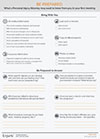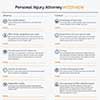What you need to know about filing a defective product lawsuit
We've all purchased an item that turned out to be defective. It happens. Often, it's just an annoyance because it costs time or money.
But sometimes, a defective product causes physical injury or property damage. If you or a loved one have been injured by a product, you might be able to file a product liability lawsuit.
When can I sue for a defective product?
The premise of civil law is that the plaintiff (the person who brings the lawsuit) aims to become “whole,” which means they want to recover an amount of money needed to restore them to their condition prior to the injury. That can mean they seek money to cover medical treatments, replacement or repair of property, or recovery from pain and suffering.
There are three main types of liability when it comes to defective products:
1. Defective design
A defective design is when a product is unreasonably dangerous by design. In other words, even if it’s manufactured exactly right according to its specifications, the product is inherently dangerous. Often, the court will determine that the product could have been designed in a way that was safer to use, while still serving its intended purpose.
Example: A toy marketed for use by toddlers has small pieces that present a choking hazard. This is a design defect because a toy for children that age should not be designed to be small enough to go in the mouth.
2. Manufacturing defect
A manufacturing defect occurs when a product that is safe by design has become unsafe because of a mistake in the manufacturing process. For example, a chair that is designed to have four standard-length legs could accidentally be manufactured with three standard-length legs, and one that’s too short. If that short leg causes the chair to tip, and the user falls off and becomes injured, that could be a cause of action for a manufacturing defect.
Example: A seat belt buckle in a car cracks during normal use. It was designed to withstand normal wear and tear, but the material in this particular buckle was too thin, which caused the user to become injured in a crash.
3. Failure to warn
If a product has risks that aren’t obvious, or that the average user is unlikely to anticipate when using the product in its intended manner, the manufacturer has a duty to warn the consumer of those risks. That’s why, for example, you probably see stickers on most electrical appliances that warn of the risk of electric shock if they come into contact with water. The caution page of any instruction manual is the way that manufacturers warn of foreseeable risks with normal use of a product.
Example: A person is hit in the eye by a pebble that was propelled at high velocity from the chute of a lawnmower as another person was cutting their grass. The manufacturer didn’t warn the user to make sure that anyone else in the vicinity stay clear of the machine by at least a certain number of feet.
Although the standards set forth by the Consumer Product Safety Commission (CPSC) for product safety are much stricter than ever before, there are still dangerous products that make their way into the marketplace. The CPSC reports there are nearly 30 million injuries and 22,000 fatalities caused each year by defective products. When you see a recall on a product you own, it’s worth paying attention—returning or modifying a defective product could save your life.
If you’ve been injured by a defective product, you might be able to bring a product liability lawsuit.
What do I have to prove in a product liability lawsuit?
Under Georgia law, the plaintiff has to prove that the product was defective in order to recover damages in a product liability case. In order to do this, the case must prove these four elements:
- The product was defective at the time of the injury.
- The defect was the cause of the injury.
- The product was substantially the same when it caused the injury as it was when it left the manufacturer. In other words, if the defendant (manufacturer) argues that you modified the product to an extent that made it dangerous, but it wasn’t dangerous when you bought or received it from the manufacturer, then it might be able to successfully defend against your claims.
- The product was being used in a way that was reasonably foreseeable by the defendant (manufacturer). That means when the injury occurred, you were using the item either in a way that it was designed to be used, or in a way that’s common enough that the manufacturer had to anticipate that it could be used for that purpose. For example, going back to our chair with the short leg... a chair is intended for sitting. But, it’s common for people to stand on chairs to reach something up high. If the accident happened when you were standing on the chair, it’s possible that your lawyer could make a successful argument that it was still being used in a way that was foreseeable.
Tweet this
What’s the time limit to bring a product liability lawsuit in Georgia?
You have two years to bring a lawsuit for a product liability or defective product injury case in Georgia, and four years if the claim is for property damage. The clock begins to run the moment you discover the injury and that it was caused by the product.
Georgia limits the time for a product liability lawsuit to 10 years from the time the item was purchased. So if that chair with the short leg is in your house for 11 years when you first take it out and fall off because of the short leg, your time frame would likely have passed.
I think I have a case for product liability. How do I begin?
Start with our Georgia personal injury lawyer directory to find a personal injury lawyer who you trust to handle the case. Enjuris also offers a guide to finding the right personal injury lawyer to represent you, along with interview questions to ask and other strategies for evaluating your options.
 Your First Meeting with an Attorney
Your First Meeting with an Attorney
A worksheet to prepare for your first meeting with a personal injury attorney – what to bring, what they'll ask
Download in PDF format![]()
 Personal Injury Attorney Interview Sheet
Personal Injury Attorney Interview Sheet
Worksheet with questions to ask a personal injury attorney to help determine if he or she will be a good fit for your case
Download in PDF format![]()
These personal injury guides will help you in your first meeting with your lawyer to present the facts clearly and efficiently so they have the necessary information to build your case.
Did you know that product liability law varies by state?
There are several dangerous intersections in Macon and some unsettling local data about traffic accident fatalities in recent years. Learn about the statistics, laws and how to find an injury lawyer.
More on Macon car accident statistics & what to do after a crash
Need a lawyer?
What does an injury lawyer do?
A personal injury lawyer helps individuals who have sustained injuries in accidents to recover financial compensation. These funds are often needed to pay for medical treatment, make up for lost wages and provide compensation for injuries suffered. Sometimes a case that seems simple at first may become more complicated. In these cases, consider hiring an experienced personal injury lawyer. Read more















